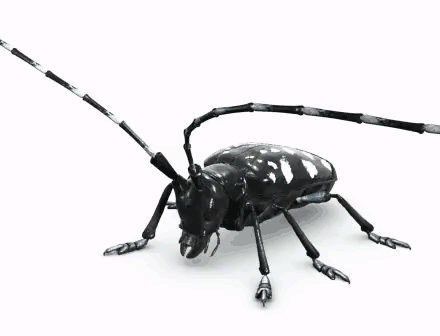
Asian longhorned beetle. Image: USDA
By Angelica A. Morrison
This story originally appeared on Great Lakes Today and is republished here with permission.
The US Department of Agriculture is asking residents along the Great Lakes corridor and beyond to watch out for an invader- the Asian Longhorned Beetle.
The bug is definitely creepy. It has long antennas with white stripes. And a black glossy exterior with asymmetrical white spots. It can fly, but it doesn’t like to, said Andrea Locke the coordinator for WNY Prism, the organization was hosting the invasive clean up.
“This particular bug, it’s impressive. It’s a large bug. It’s about an inch to an inch and a half in size if folks see it they’re going to notice. It’s just a matter of connecting that noticing the bug and understanding that this is something that people need to report,” Locke said.
Essentially, the insect eats the tree from inside out. It burrows deep inside and lays eggs. The larva grows into an adult. It emerges leaving an exit hole. Its damage trees can’t usually recover from.
But, what does the damage look like?
You might see dime sized holes in the trunk or branches. Sometimes you’ll see tunneling marks. There’ll also be a sawdust like material on the ground.
“The Asian Longhorned Beetle is one of the most destructive forest pests that could have entered the United States,” said Rhonda Santos of the USDA.
The organization is trying to eliminate the bug. They inspect and remove infested trees. They also set up quarantine areas. So far, the bug has led to the loss of more than 160,000 trees across the nation.
It was first detected in the US, in 1996. Experts believe it came from wooden packing material, used in cargo shipments from China.
“When we find an Asian Longhorned Beetle infestation it usually takes at least 10 years to be able to eliminate the beetle from that area. That goes back to finding every infested tree, removing it and, continuing to search the remaining trees, to make sure the beetle is not there,” she said.
The bug was eliminated from areas in Illinois and New Jersey. There are still active infestations in Ohio, Massachusetts, New York and Canada. This summer, the quarantine in southwest Ohio was expanded. Santos says they were proactively searching about a mile outside the zone and found a bug.
“There’s a concern that this insect can be where we don’t know it to be already. And certainly for the Great Lakes region, where you have so many trees,” Santos said. “Particularly, in the northern border of the US, those trees go right into Canada and because we have so many trees, that’s a greater risk that this pest could go after those trees in that area.”
Report findings at https://www.aphis.usda.gov/aphis/home/